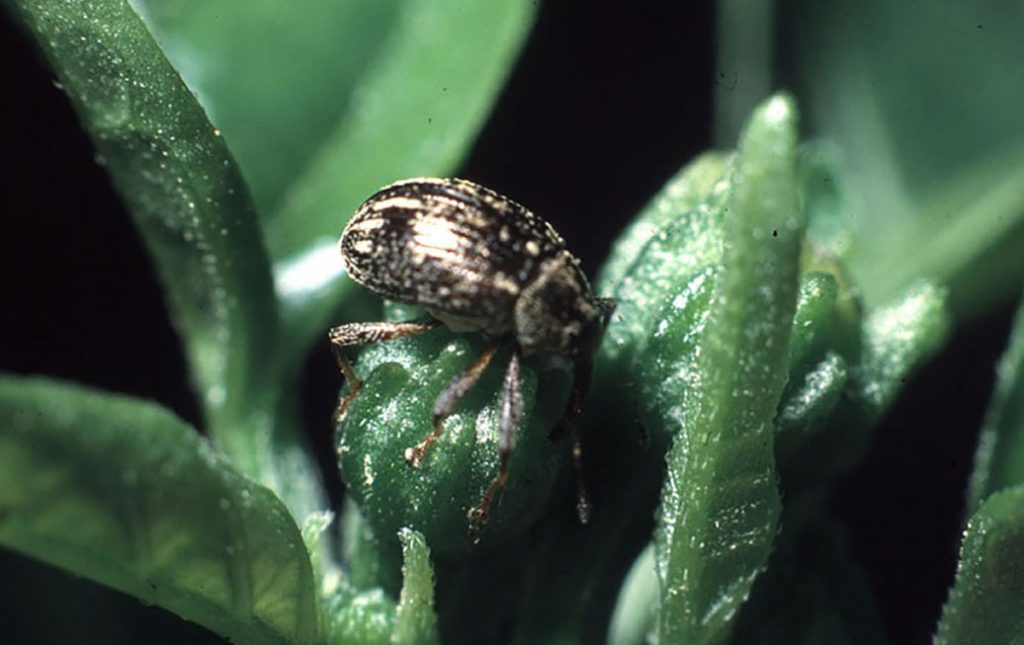
By Gene McAvoy
The pepper weevil (Anthonomus eugenii) is a key pest of all pepper varieties grown in Florida. Populations build throughout the season and often reach unmanageable numbers in South Florida in the late spring (early fall in North Florida), resulting in crop loss. In South Florida, it is not unusual for growers to terminate older plantings where weevils have become unmanageable.
Identification and Damage
The major form of damage is destruction of blossom buds and immature pods. Both adult and larval feeding causes bud drop.
Larval feeding within the mature pod is another important form of damage, causing the core to become brown, moldy and unmarketable. The stem of pods infested by larvae turns yellow, and the pod turns yellow or red prematurely. Fruit drop is common and is perhaps the most obvious sign of infestation. Damage by pepper weevil may also allow fungal pathogens to infect fruit, resulting in extensive fungal growth within pods.
In the absence of pepper blossom and fruit, adults may feed on leaves and stems.
The female weevil bores a small hole in developing fruit or flower buds. The hole is plugged with fecal matter (frass) after an egg is deposited. Females deposit five to seven eggs per day.
The larvae are white to gray in color, with a yellowish-brown head. The larva hatches from the egg and eats its way toward the seed core of the fruit, where it feeds on seeds and pulp and passes through three larval instars.
Pupation takes place inside the fruit within the cell created by larval feeding. The emerging adult may feed within the fruit for a while before escaping through a circular hole chewed in the wall of the fruit.
Black nightshade serves as a secondary host and can maintain small numbers of pepper weevil during fallow periods. Adults readily migrate from old fields to new plantings, causing populations to build up as the season progresses.
Management Methods
Fruit and flower buds should be examined for damage and fallen fruit. Examine buds for the presence of larvae.
Infested fruits can be recognized before they fall by the yellow calyx and the presence of oviposition punctures that look like small dimples. If possible, all damaged and fallen fruit should be removed and destroyed. Hot peppers like Jalapeño and Serrano are often the first peppers to be affected.
Chemical control is difficult because all stages, except the adult, are protected within the fruit. Therefore, only the adult weevil is vulnerable to insecticides. Frequent sprays may be necessary, starting in the initial stages of infestation, to avoid unacceptable levels of damage.
Spraying needs to commence at the first sign of weevils or with flowering in fields with a history of problems. Vydate has been the standard control used in combination with other products like Capture (bifenthrin), Kryocide (cryolite) and Actara (thiamethoxam).
Many of the currently labeled materials are difficult to work into an integrated pest management (IPM) program once peppers begin to be harvested. This is due to the seven-day postharvest interval in force for all materials. This is particularly true for hot peppers, which are often harvested multiple times during a week. Consult University of Florida Institute of Food and Agricultural Sciences recommendations for currently labeled insecticides for pepper weevil control in Florida vegetables.
In addition to chemical controls, a complete IPM approach is recommended for pepper weevil management. Adjacent or nearby sequential plantings should be avoided. Sanitation is important. Crops should be deep plowed immediately following harvest and after treating with insecticide to reduce adult movement into nearby fields and to reduce survival over the summer. A crop-free period helps reduce populations between crops. Nightshade in and around fields should be controlled to reduce population survival between crops.









